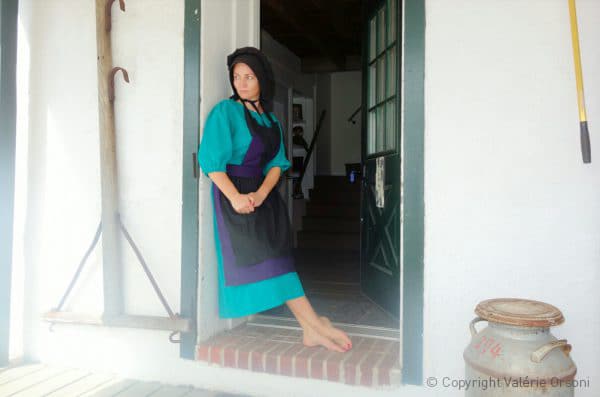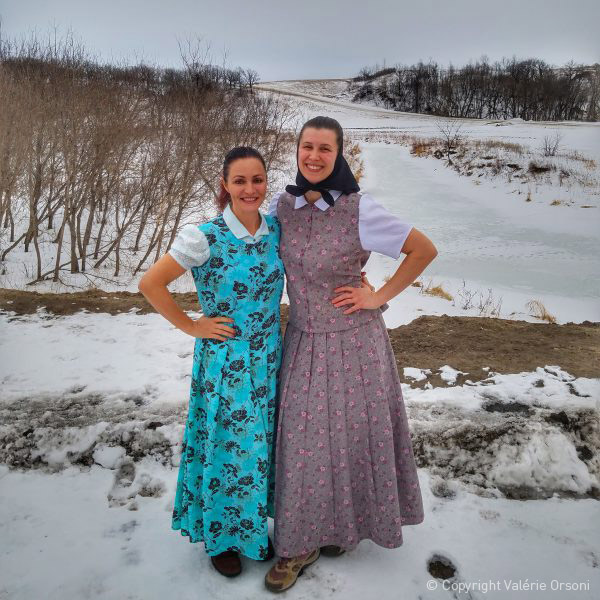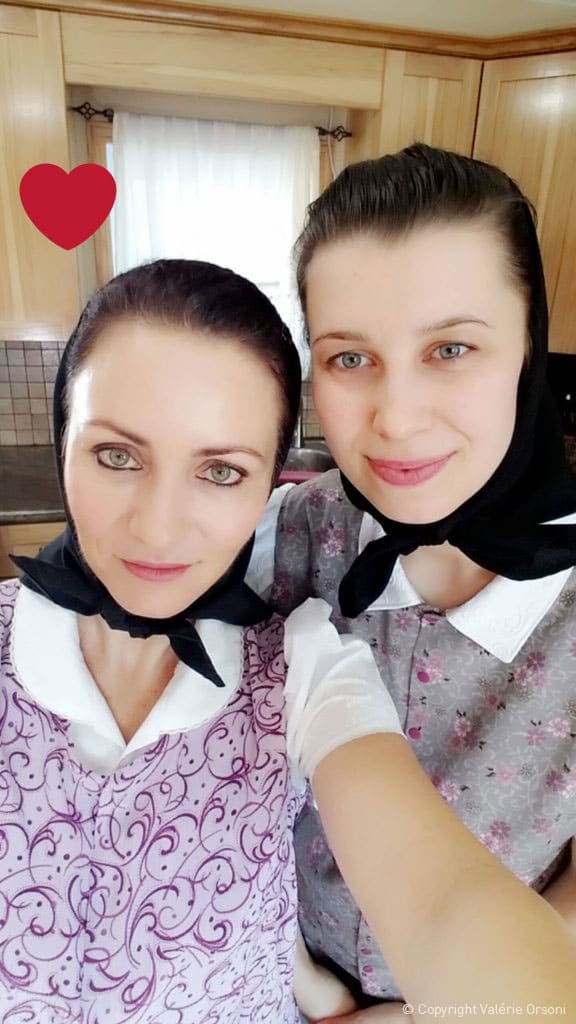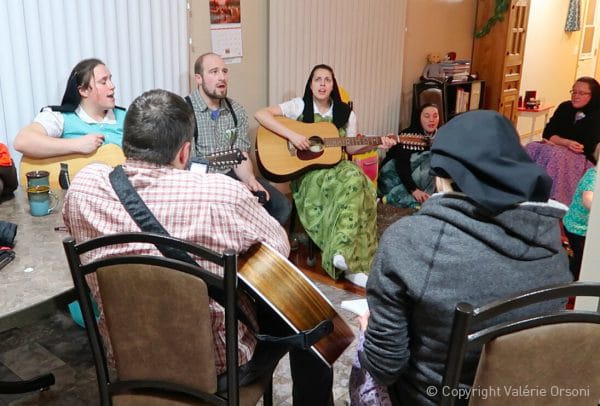
I have read pretty much everything that has been written on the Amish, I’ve taken a trip to spend a week on an Amish farm, and I even did a TV show on this subject with FOX TV. Indeed, when I want to learn about a new culture, I like to experience it fully and authentically – 100% cultural immersion!

Early last year, as I was doing some research on the Amish and the Mennonites, I came across a group I had never heard of before: the Hutterites. A quick Google search brought light to this intriguing branch of the Anabaptist movement: Like the Amish, the Hutterites believe in adult baptism, but their communal way of life sets them apart from other Anabaptists.
The very first results I found on the internet included a bunch of calumnious writings, among them two books written by nine former Hutterites. As this sounded too bad to be true, I decided to dig deeper. I soon stumbled upon an article written by Carol Maendel, published on hutterites.org. In it, she addressed some of the accusations and misconceptions about her faith and way of life, but also offered to exchange with individuals truly interested in knowing more about the Hutterite lifestyle, going so far as to extend an invitation for them to visit her community.
At first I thought this was all a publicity stunt, but I decided to take her at her word. So I sent her some snail mail to which she responded, and what followed was a heartwarming 18-month exchange: parcels of homemade goodies, phone calls, emails, etc…

When I finally had the opportunity to go and pay Carol a visit at her Forest River Colony in North Dakota, I grabbed it.


I must say that for a unique situation like this, where an outsider like myself could easily be viewed as a threat with a negative media agenda, I was floored at how generously the Hutterites opened their hearts and homes to me.

I asked hundreds of questions – some silly, I’m sure – but each one was answered with thought and respect. I was invited to share in their meals and their church services, to visit their communal kitchen, to freely roam around the colony, and most importantly, I got to spend time with Carol, her husband Sir Brian (pun intended since Brian never got formally knighted by the Queen), and her two little girls: Ashley-Rose and Petra.

Before I share with you the soul of this people, let’s have a quick look at the when, where and what of the Hutterite movement:
- When: Began in the 1500s, Jakob Hutter (whom the movement is named for) was elected chief elder in 1533.
- Where: Today in Canada (BC, AB, SK, MB) and North America (WA, MT, ND, MN, OR, SD)
- What: Approximately 490 colonies exist today. The movement consists of 3 distinct groups, Schmiedeleut, Dariusleut, Lehrerleut. They all share the same heritage and doctrine, and differ only in their dress, leaders and location.

And now, here are the nine things I have learned about the Hutterite lifestyle.
1. Community: theirs is truly a shared lifestyle from dining to laundry. An average colony comprises 100 members; above that number, the colony will split into two. Houses are assigned to families based on size, and members don’t own their homes. Instead of fully equipped kitchens in each house (though they do have basic kitchens for times when they receive guests and/or cannot go outside), a team of women cook meals for the entire colony and members eat together in a communal kitchen. A central laundry room is also shared among the members (no private laundry rooms). All of these elements naturally foster a greater sense of community and camaraderie.


The Hutterites practice traditional gender roles, and women cannot vote or hold colony office. It might sound shocking to some of us – especially if you are a feminist – but if this what you were raised with, it’s simply cultural. Adolescents become adult members at age fifteen and are eligible for baptism at age twenty. At this age, a Hutterite woman generally leaves her colony to marry a man in another colony, which receives a dowry in exchange. For instance, Carol left her Kilby Butte Colony in Montana to go to Brian’s colony at Forest River.
Each house is equipped with an intercom that rings for the three meals and for religious services. In case one cannot go to church (in this colony the church was underneath the kitchen) one can listen to the service from the comfort of one’s home.

2. Family: they live by strong family values. Children are raised with abundant care and attention and are not left to fend for themselves. Education at home and school is important. Divorce is forbidden, reflecting a belief in and value of the deep work it takes to keep a marriage and family together.


3. Freedom: colony members can come and go as they please, this is not a locked compound! The best proof? Carol came to pick me up at the airport and we went shopping before returning to the colony. They visit family members who live in other places, states and countries, and can even formally leave the colony and return without being shunned for life. No vacations to Bora Bora though, this is simply not their style :). Carol is definitely interested though, just sayin’!

4. Welcoming: the Hutterites are happy to share about their way of life. They answered my questions, invited me to church and into their homes, and even offered me to wear their clothes. They politely switched to English from their Hutterisch dialect every time I came into a room so that I would never feel left out. When I made it to church, even the sermons were presented in English! They showed me around the entire colony and I got to enter every single building I wanted to visit: from the big barn (warning: if you truly want to see it all, a shower and change of clothes is required before entering as this is a highly maintained, disease-free area), egg production plant and greenhouse, to the laundry, church, communal kitchen, cellars (special shoutout to JoAnn who took me all over the cellars and kitchen and answered all my cooking questions – even letting me add some spices here and there), and members’ homes.

5. Technology: not like the old order Amish! They have electricity, cars, huge trucks, computer-managed hog operations, internet, and more. They have computers in their well-equipped schools as well. However, they don’t have TVs in an effort to better preserve communication and exchange amongst colony members. Note that the Hutterites struggle as we all do to use technology (i.e. smartphones) for beneficial purposes and to prevent misuse amongst its members. They seem to be doing something right on this front, as you certainly don’t see people walking around the colony in a zombie-like state, texting, facebooking, tweeting or whatsapping their friends. A sight for sore eyes!
PS. Regardless of their openness to new technologies, I did not feel comfortable to film every single minute of my stay, nor film people I did not know or certain places like the inside of the church. It is what I call respect. I could not see myself putting a lens in the face of every single person I came across.

6. Faith: they attend church almost every day, for at least a half-hour service each time. On Sundays, two services take place. If you miss a service, there are no penalties. Of course, if you miss too many services that’s another story! Each house features a general intercom system through which one can listen to the daily sermon from home, which is practical if one is sick or at home babysitting small children. Indeed, contrary to the Amish, babies aren’t brought to church. God is undoubtedly the center of Hutterite life.

7. Fun: Apparently being serious about one’s faith does not prevent you from telling jokes, teasing, and sharing fun times with friends and family. I did pull Brian’s leg a bit because of his low number of steps per day and he took my constructive criticism (and sometimes, sarcasm) in stride! Be warned, next time I come, I’ll be organizing some fitness classes! Humor is definitely one of the keys to a happy life. When there are guests visiting the colony, an evening might involve gathering at someone’s home for singing and guitar playing (amazing voices singing By The Rivers of Babylon – priceless!), engaging conversation, a hockey game (thank you Jared for strongly suggesting I should give it a try, I shall learn and train and come back ready to glide on the ice without looking too ridiculous), or a volleyball game in the school gym.


8. Self-sufficient & frugal: they produce a maximum of the goods they need, reuse, recycle, and fix things as much as possible on their own. They produce the vast majority of the fruits/vegetables/meat they consume and make products we usually buy, such as clothing (dresses, shirts, underwear), and even beauty products. Stay tuned on my YouTube Channel for the coffee-sugar face scrub video we made with Carol!



9. Resilience: if there is one trait that marks the Hutterites, it is resilience. They are a people who know what it means to stay the course, to uphold, to endure, to build, to persevere, and to grow.


I gave a few books away so I am hoping some of the people there will be able to lose those extra pounds.
And because they are not so active during the winter I suggested they use my LeBodyChallenge, a 12-week fitness program, from the comfort of their home, too. I shall see the progress some of them have made upon my return ;).
I was warned by Carol that Hutterites can be blunt, but frankly – and maybe it’s because I am Corsican and Corsicans are known to be blunt too – I did not experience that at all!
I feel truly privileged to have been able to spend a few special days with this amazing group of people. And I look forward to returning during the harvest season when the colony is in full throttle mode. Speaking of harvest, Hutterites consume buckwheat as part of their diet so I could not resist shooting a cooking video with Carol, which you’ll get to see soon on my LeBootCamp YouTube Channel!
I would like to close this article with a deep and heartfelt thank you to the Hutterite people of Forest River Colony and most particularly to Carol and her husband, Brian! Thank you for welcoming me with open arms and for sharing a slice of your life with me. I think this poem I wrote can truly apply to the way you lead your life.
PS. Because I love exploring other cultures, there will definitely be more new and intriguing stories to come! So stay tuned by subscribing to this blog and to my LeBootCamp YouTube Channel to receive an alert the next time I share such an experience.
Disclaimer: I have only visited one Hutterite colony. There are hundreds. Every colony abides by its own system of rules, so my story remains what it is: a unique one-place (but hopefully not one-time) experience.

Tags: Amish anabaptists commune culture discovery faith hutterite hutterites Mennonites north dakota religion religious tradition traditional

















Leave a Reply